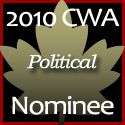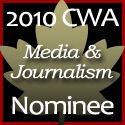The Canadian Manifesto: How the American Neoconservatives Stole My Country
In November of 1922, a Mr. K. Friedrich visited Harvard University to speak to their Liberal Club about post-war Germany. He gave an animated account of a new phenomenon: the "Youth Movement" or "Gugenelbewegung."
"'The Youth Movement' expresses the new spirit in Germany. It feels that the old life was cold, hard and unprofitable, stifling all the better instincts of the young people of the nation. The old militaristic system could not be called culture.When we think of a German Youth Movement, we automatically think of the Hitler Youth, and the disturbing images of indoctrinated children proudly giving the infamous salute. However, the youth movement actually began before the War, as a vehicle for young people to commune with nature and escape the oppressive regime of Wilhelm II. Their hikes were intellectual and cultural endeavours, as they shared poetry; discussed and debated philosophy, current events and politics. And while many groups had uniforms, more common would be musical instruments and books.
"It was merely a mechanical perfection, wholly lacking in spontaneity. The 'Youth Movement' is embracing a different theory of values in the educational standard. The tendency is constantly towards a more liberal ideal. Its studies are more and more in the realm of Philosophy, Literature and Religion. The old shackles are being cast off by a new and spontaneous enthusiasm." (1)
During the war, the movement gained momentum, when shortages in essentials, resulted in many schools being closed; so for children and young adults, these hikes provided their education. After the war, the groups began to organize and many became more political in nature; some even sponsored by political parties.
The German Zionist Youth Movement
Leo Strauss, the German emigre who inspired the neoconservative movement, would become an active participant in the Zionist Youth Blau-Weiss, then led by Walter Moses. And while the group enjoyed the typical hikes in the mountains, they were also very militaristic. Strauss would refer to it as pagan-fascism, and indeed Moses liked to imitate Mussolini, who had come to power in 1922.
It was here that Strauss claimed to have nurtured his authoritarianism, and the concept of a "clique", led by a dictatorial style leader. As early as 1923 he spoke of a preference for a quasi-totalitarianism, and detested “bourgeois” or “liberals” seeking to preserve their lives and comfort.
He would actually try to join the Nazi Party but was turned away because he was Jewish. Said Strauss of Hitler, his “political theology” was hostile toward “me and my kind”. (2)
You Don't Have to be German to be a Hitler Youth
When civil rights activist, Tom Hayden, (formerly married to Jane Fonda) was a student at the University of Michigan, he became the editor of the Michigan Daily, and one of the founders of Students for a Democratic Society. SDS was in direct contrast to Young Americans for Freedom, and the two groups often clashed.
In one article of Hayden's in the Daily, he compared YAF to the Hitler Youth. They were certainly cult-like, in their attempts to dress and act like William Buckley Jr., and accepted no opposition to any of their arguments, which they like Buckley, were always well prepared for.
YAF responded to Hayden's article in their own newsletter. "Next to the Twist and barely knee-length skirts, the most fashionable thing of the season is the rousing , vitriolic attack on the so-called 'Extreme-Right'".
Buckley approved of the counter-attack, but privately he worried that Hayden was right. The John Birch Society, that was providing funding and moral support to the conservative youth group, had suggested in one of their reports, that if Barry Goldwater lost the 1964 nomination, they would assemble forces in his [Goldwater's] fascist army. (3)
Leo Strauss would develop a philosophical argument which he called Reductio ad Hitlerum. What he suggested was that not everything Adolf Hitler did was bad, and using examples like Hitler was anti-smoking, loved dogs and was a vegetarian, we can't automatically think of those things as bad, just because they were associated with Hitler.
Of course Hitler was not a vegetarian, but loved wild game, sausages and caviar, (4) and in 1926, apparently in order to impress Mimi Reiter, a 16-year-old girl, he whipped his dog so savagely that it terrified her. (5)
This does speak to another aspect of neoconservatism. The power to deceive, in order to create a public persona that the masses can get behind.
Strauss is right however, to suggest that not everything Hitler did was bad and in fact the political strategies that the neoconservatives adopted, were like time delayed synchronized swimming. They followed his path to power, almost to the letter. I'll be getting into that in more detail, later.
However, Hayden was not off the mark.
Two Burning Images
Undampered by a chilly drizzle, some 40,000 Germans jammed the square between Berlin's Friedrich Wilhelm University and the Opera House looking at a black mass of criss-crossed logs, insulated from the pavement by sand. A thumping band blared out old military marches. Toward midnight a procession entered the square, headed by officers of the University's student dueling corps in their dress uniforms: blue tunics, white breeches, plush tam o'shanters and spurred patent leather jack boots.
Behind them came other students and a line of motor trucks piled high with books. More students clung to the trucks, waving flaring torches that they hurled through the air at the log pile. Blue flames of gasoline shot up, the pyre blazed. One squad of students formed a chain from the pyre to the trucks. Then came the books, passed from hand to hand while a leather-lunged student roared out the names of the authors:
"Erich Maria Remarque [wild cheering]—for degrading the German language and the highest patriotic ideal!" (Remarque wrote All Quiet on the Western Front, against WWI)
"Emil Ludwig—burned for literary rascality and high treason against Germany."
"Sigmund Freud—for falsifying our history and degrading its great figures. . . ."
On he went, calling out the names of practically every modern German author with whom the outside world is familiar: Karl Marx, Jakob Wassermann, Albert Einstein, Thomas and Heinrich Mann, Lion Feuchtwanger. Arnold and Stefan Zweig, Walther Rathenau.
... While the flames flared highest, up to a little flag-draped rostrum stumped clubfooted, wild-eyed little Dr. Paul Joseph Goebbels, Minister of Propaganda and Public Enlightenment in the Nazi Cabinet, organizer of the great midnight bibliocaust. "Jewish intellectualism is dead!" cried he. "National Socialism has hewn the way. The German folk soul can again express itself!
"These flames do not only illuminate the final end of the old etra, they also light up the new. Never before have the young men had so good a right to clean up the debris of the past. . . . The old goes up in flames, the new shall be fashioned from the flame in our hearts. ... As you had the right to destroy the books, you had the duty to support the government. The fire signals to the entire world that the November revolutionaries [German Revolution that overthrew the Kaiser] have sunk to earth and a new spirit has arisen!" All over Germany similar pyres blazed with similar books. (6)
The Nazi youth were driven by anti-communism and anti-liberalism. The anti-Semitism came about because of the popular belief that the Jews were working with the Communists to take control of Germany.
The conservative youth in the early days, were also fuelled by anti-communism and and anti-liberalism, but while they didn't resort to book burning, an Indiana chapter of YAF, did make a very public display of burning baskets, alleged to have been manufactured behind the Iron Curtain.
When describing the 50 worst, they use similar language to that of the young Nazis feeding the flames.
Alfred Kinsey, et al., Sexual Behavior in the Human Male - "A pervert's attempt to demonstrate that perversion is "statistically" normal."And the list goes on. Can't you just picture them being thrown into the fire?
John Kenneth Galbraith, The Affluent Society (1958) - "Made Americans dissatisfied with the ineradicable fact of poverty. Led to foolish public policies that produced the hell that was the 1960s."
Walter Rauschenbusch, Christianity and the Social Crisis (1907) - "[The Church] should therefore strengthen the existing communistic institutions and aid the evolution of society from the present temporary stage of individualism to a higher form of communism." Eek!
John Rawls, A Theory of Justice (1971) - "The hollow soul of liberalism elaborated with a technical apparatus that would have made a medieval Schoolman blush." (7)
Even those they don't metaphorically burn, they still use to take jabs at liberal tradition. From their Best list:
C. S. Lewis, The Abolition of Man (1947) - "... reveals the true intent of liberalism"Book Burning Canadian Style
Hannah Arendt, The Origins of Totalitarianism (1951) - " ... her account of the peculiarly modern phenomenon of "totalitarianism" forced many liberals to consider the sins of communism in the same category as those of fascism, and that is no small achievement."
Herbert Butterfield, The Whig Interpretation of History (1931) - Every day, in every way, things are getting better and better? No, and Butterfield provides the intellectually mature antidote to that premise of liberal historiography." (8)
[Mark] Tushingham was just about to give a presentation on the science behind his novel Hotter Than Hell at the National Press Club. Released last November with little fanfare, it's about the Earth becoming so hot from climate change that America and Canada are at war over water. "I was entering the elevator 15 minutes before the event when I got a call on my cellphone," says Tushingham's publisher, Elizabeth Margaris at DreamCatcher Publishing. "[Tushingham] said, 'I've got bad news. I can't go.' He was told [by the Environment Minister's office] not to appear." While Tushingham himself was not available for comment, Margaris told Hour, "This is just outrageous. Mark can't talk but I can. They can't fire me. They can't gag me." (9)Conservative MP Rona Ambrose forbid any promotion of the book by Tushingham, who worked for the Ministry of the Environment. The book was fiction, though based on the results of inaction to address climate change, something the Harper government refused to admit was real. Abrose was a former consultant for the Tarsands, so was protecting her clients.
In March of 2010, Senator Mike Duffy attacked the University of King’s College and other Canadian journalism schools for exposing students to Noam Chomsky and critical thinking. “When you put critical thinking together with Noam Chomsky, what you’ve got is a group of people who are taught from the ages of 18, 19 and 20 that what we stand for, private enterprise, a system that has generated more wealth for more people because people take risks and build businesses, is bad,” said Duffy (10)
King's College responded by saying that books like Manufacturing Consent were not "part of the curriculum, though students do read some Chomsky." What they should have said was that what journalism students read was none of his damn business. How can we hope for future balance in the media, sorely lacking today, if students are only taught to think one way?
From their concerted attacks on Marci McDonald's The Armageddon Factor to Stephen Harper trying to stop the publication of Tom Flanagan's book Harper's Team (he was forced to edit out half of it), Canada's conservative movement is attempting to change the way we view ourselves and our place in the world, while creating a false public persona.
Critical thinking out. American style conservative indoctrination in.
Sources:
1. MR. FRIEDRICH TELLS OF "YOUTH MOVEMENT" IN GERMANY, the Harvard Crimson, November 22, 1922
2. Enmity and Tyranny, By: Alan Gilbert, March 5, 2010
3. Before the Storm: Barry Goldwater and the Unmaking of the American Consensus, By Rick Perlstein, Nation Books, 2001, ISBN: 0-8090-2858-1, p. 154
4. Hitler: Neither Vegetarian Nor Animal Lover, By: Ryn Barry, Pythagorean Books, 2004
5. The Psychopathic God: Adolf Hitler, By: Robert G.L. Waite, Basic Books, 1977, ISBN-10: 0306805146
6. Bibliocaust, Time Magazine, May 22, 1933
7. The Fifty WORST Books of the Century, Intercollegiate Society Institute
8. The Fifty BEST Books of the Century, Intercollegiate Society Institute
9. Tories muzzle environmental scientist: Catch a fire, by Julie Fortier, The Hour – April 20, 2006
10. Mike Duffy slams journalism schools for thinking critically, By Paul McLeod, Metro Halifax, March 16, 2010






No comments:
Post a Comment